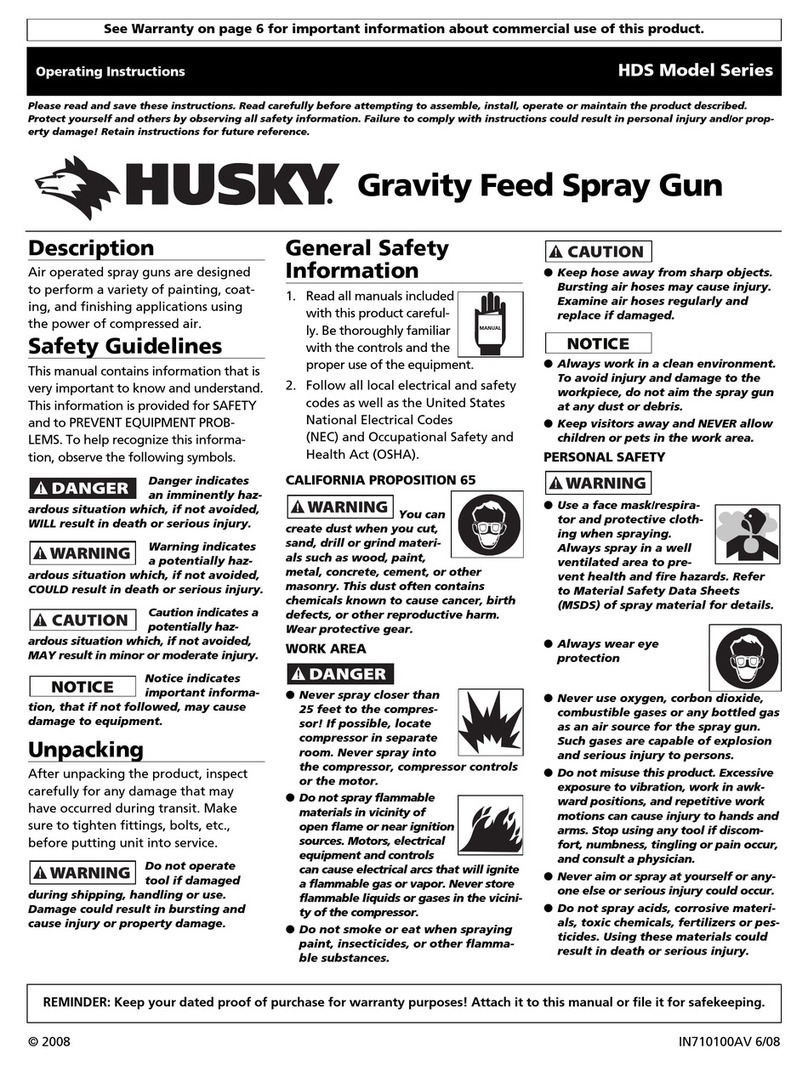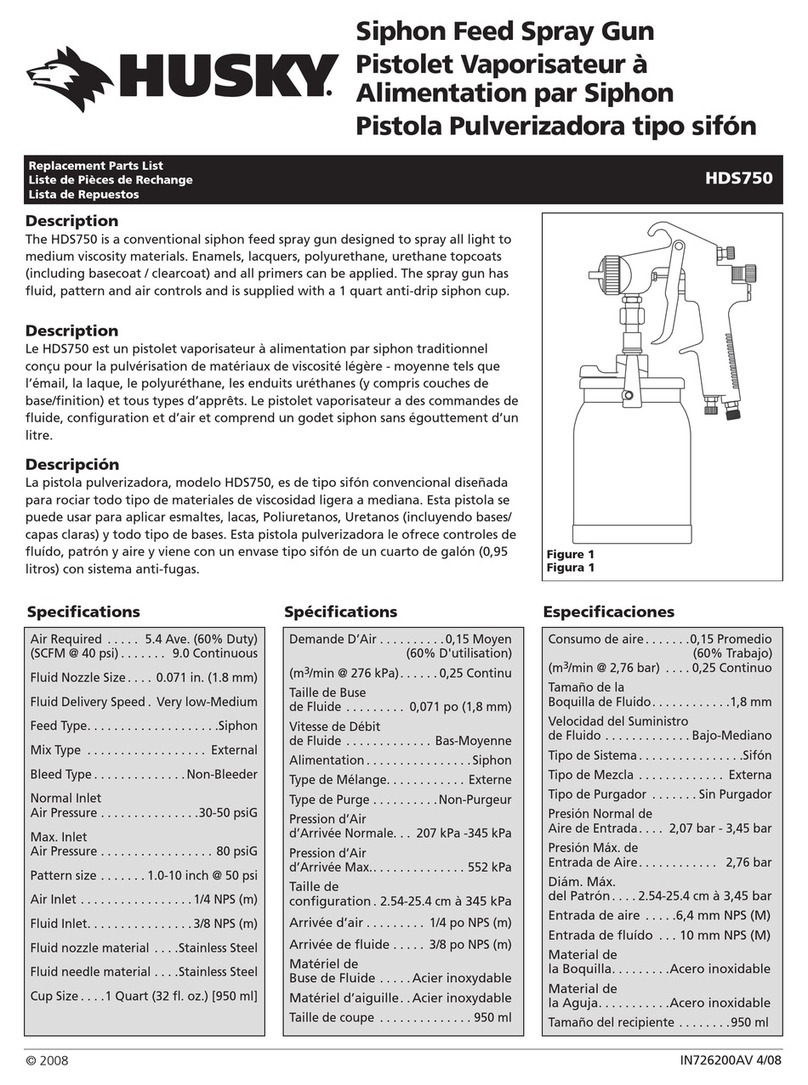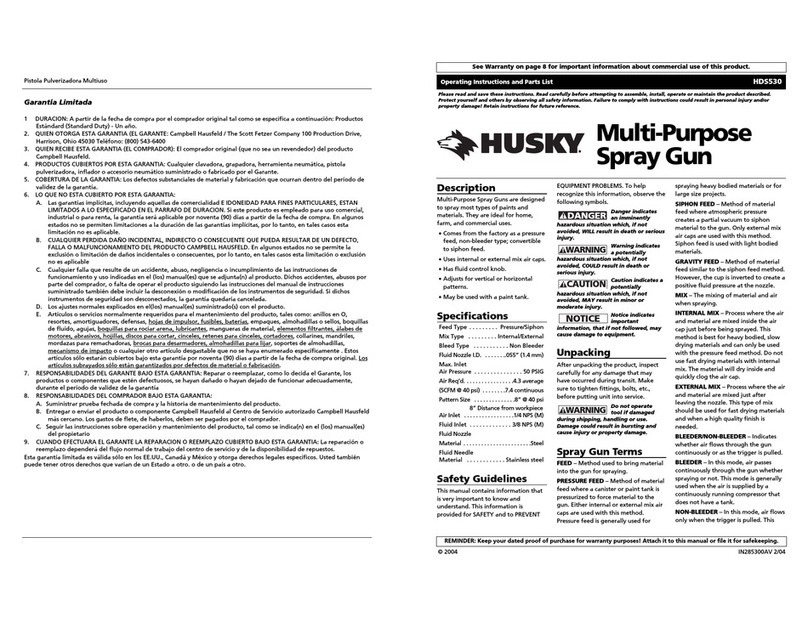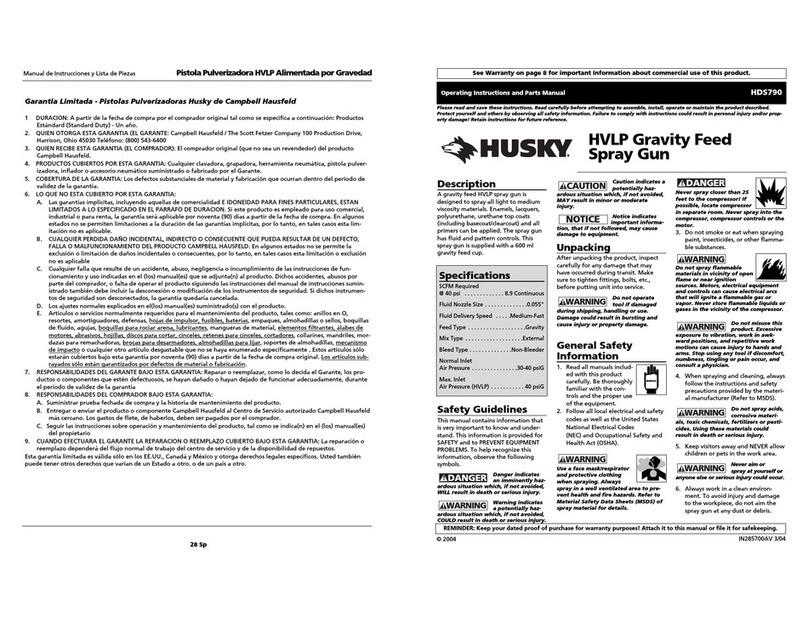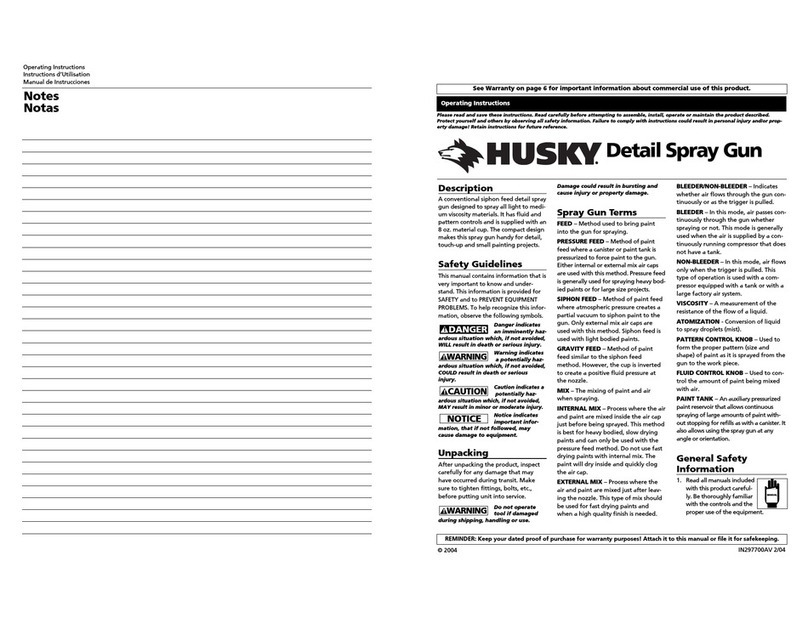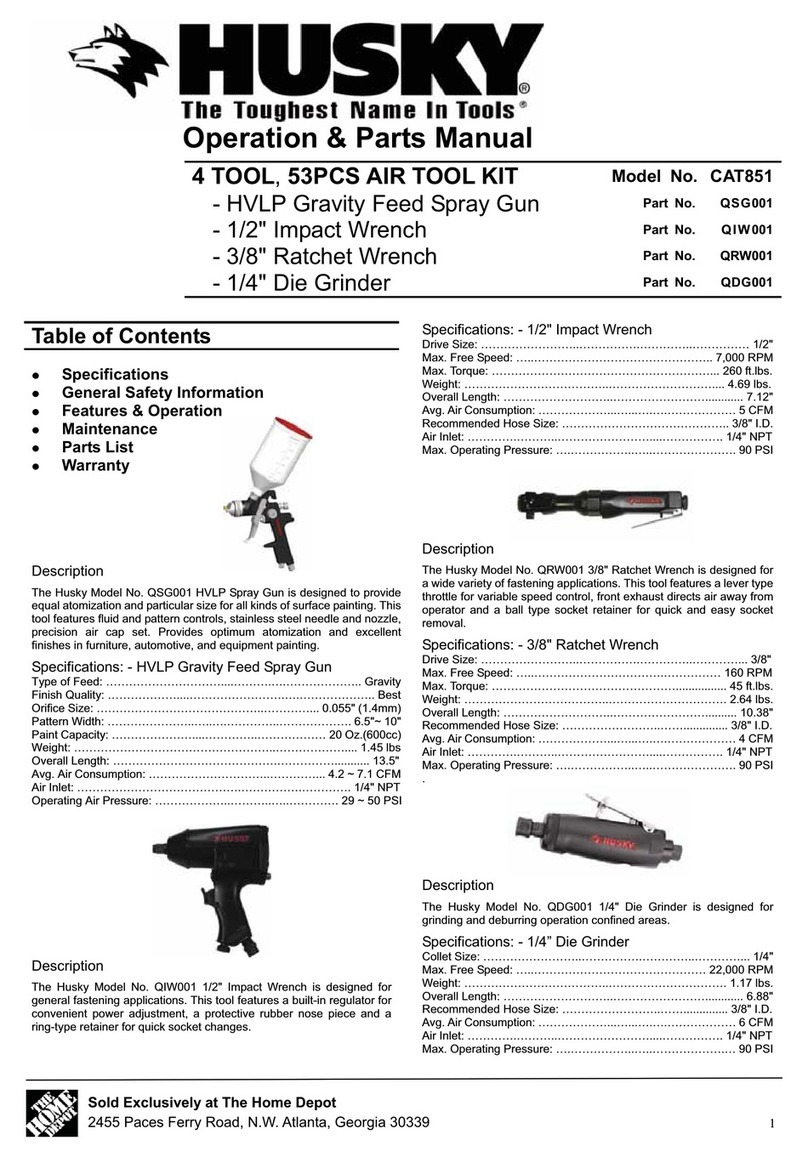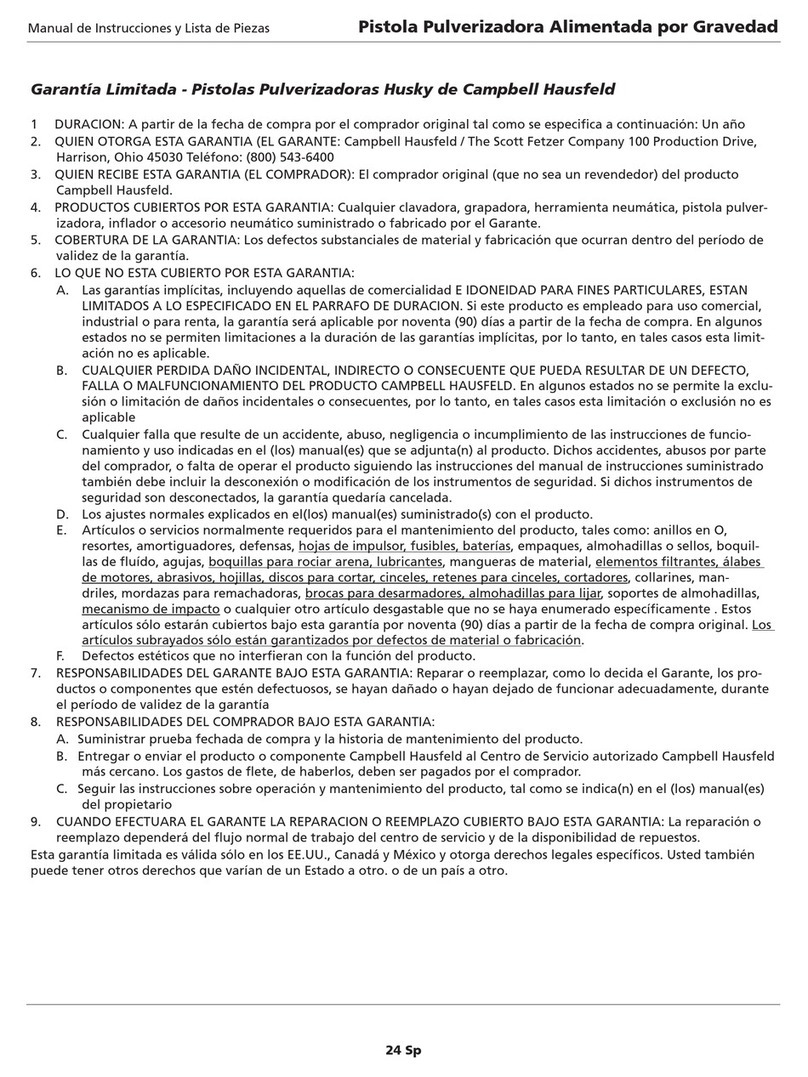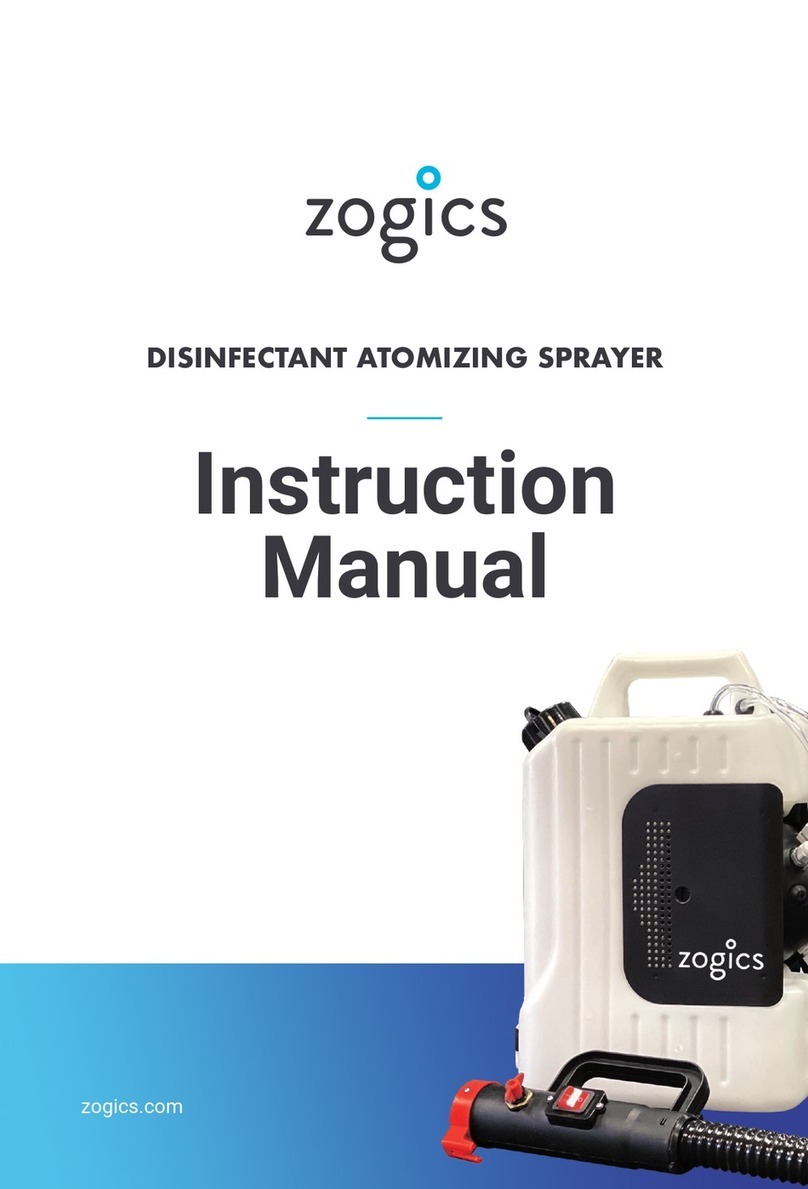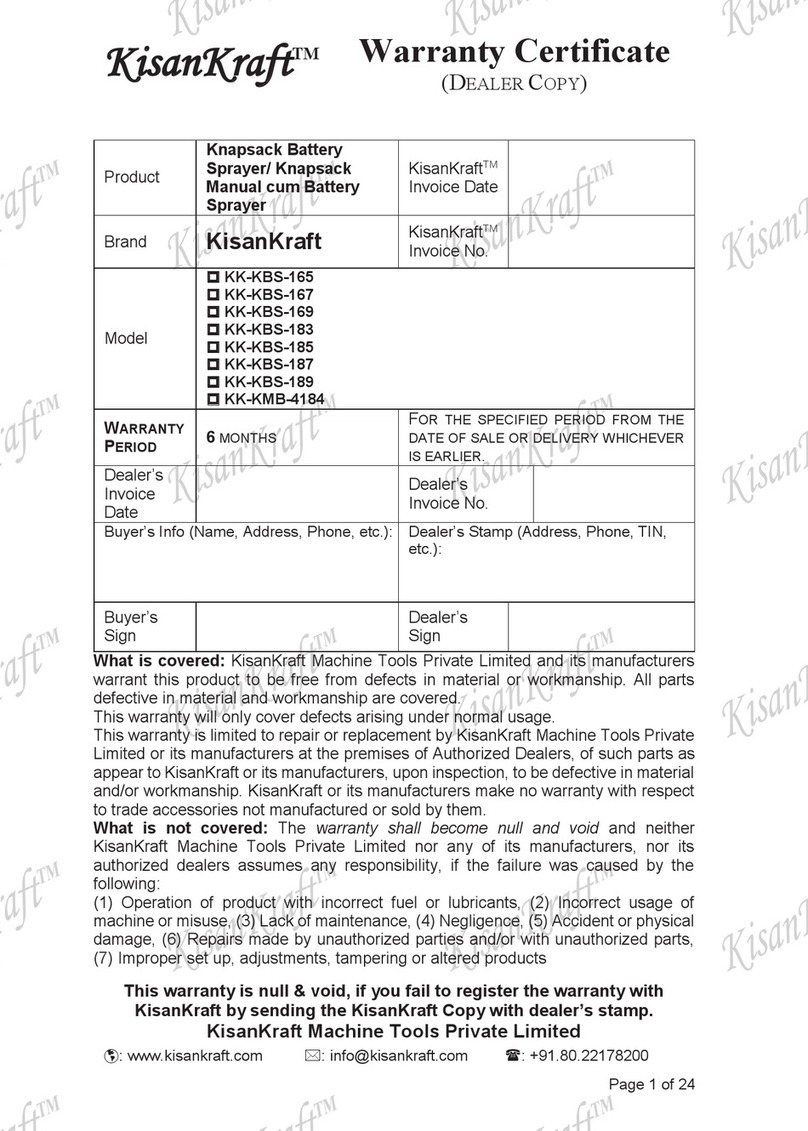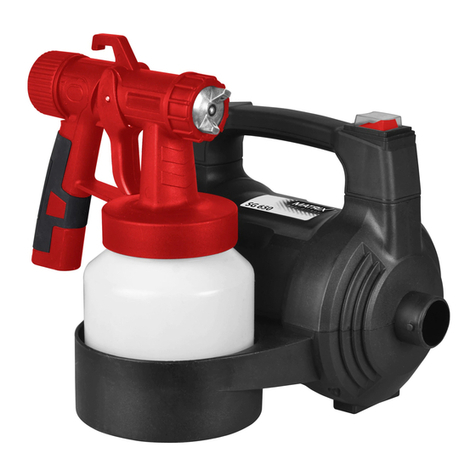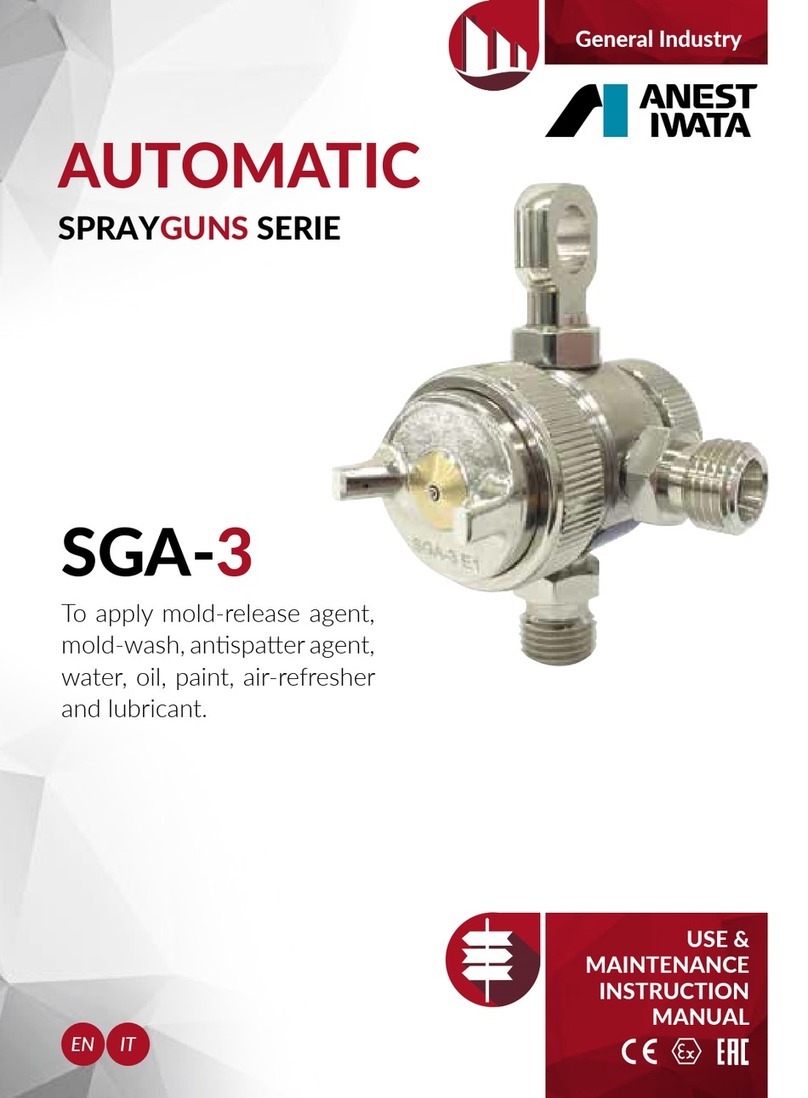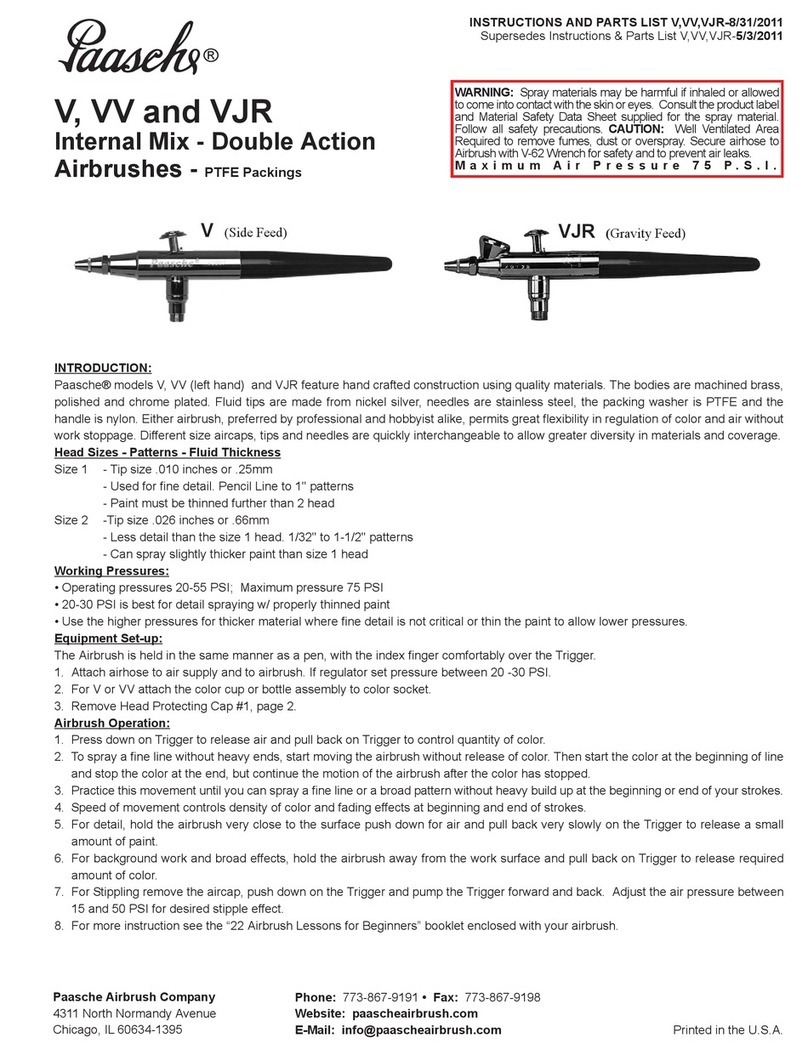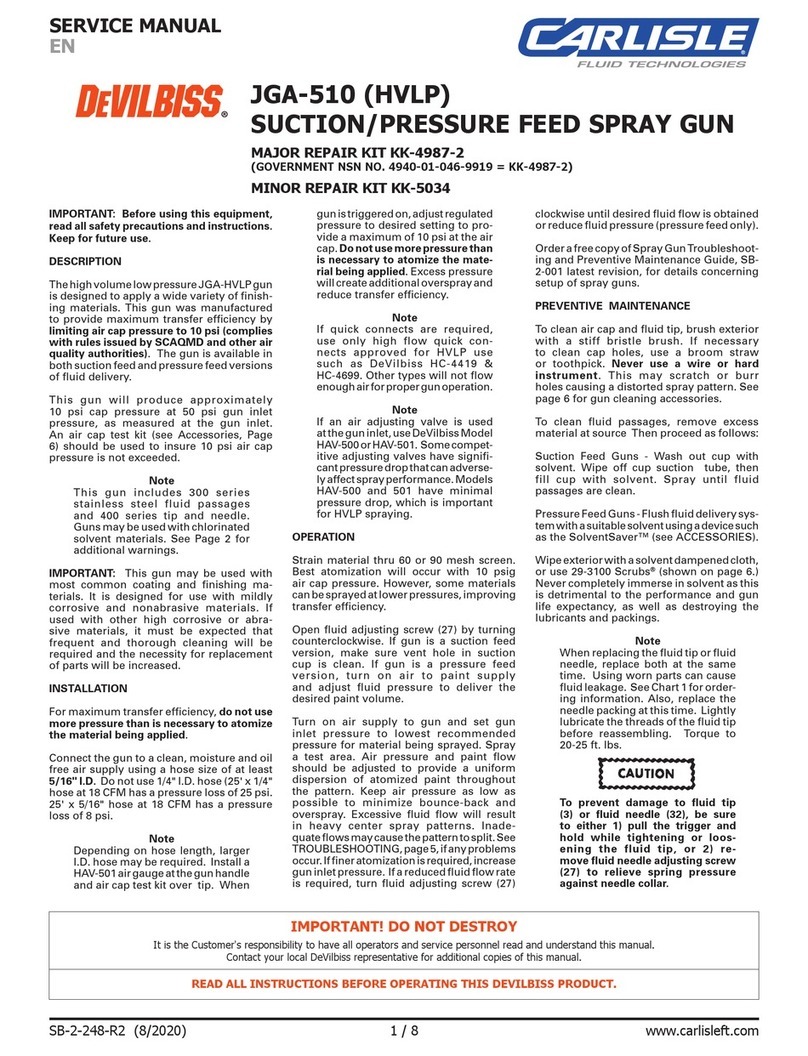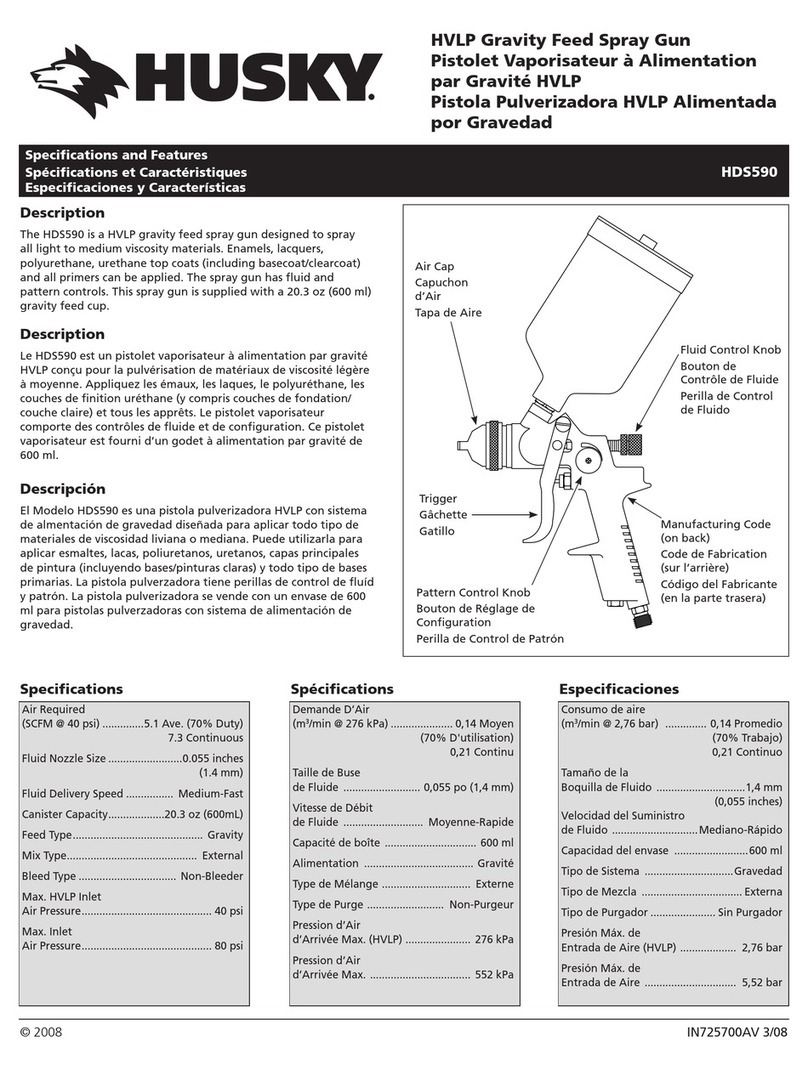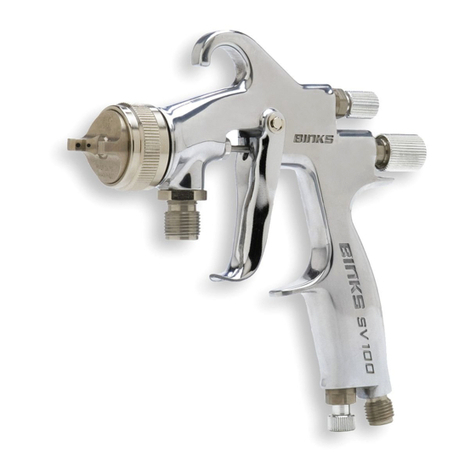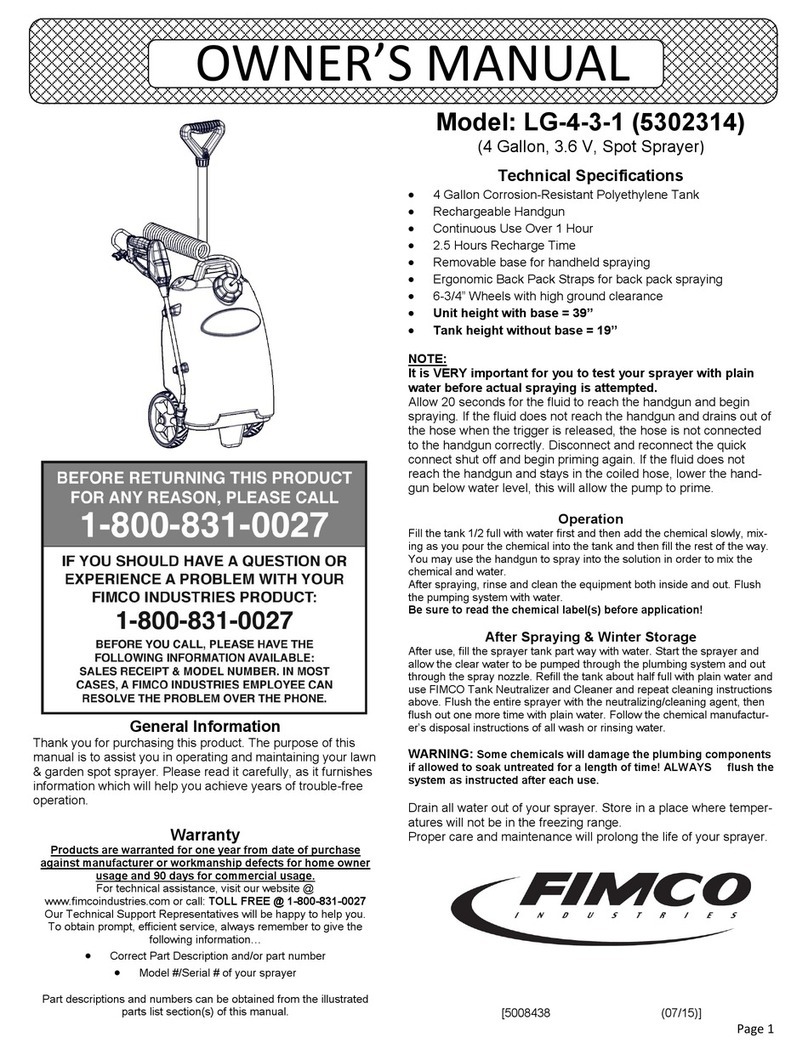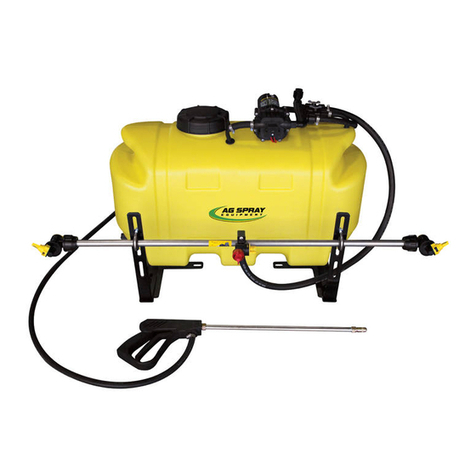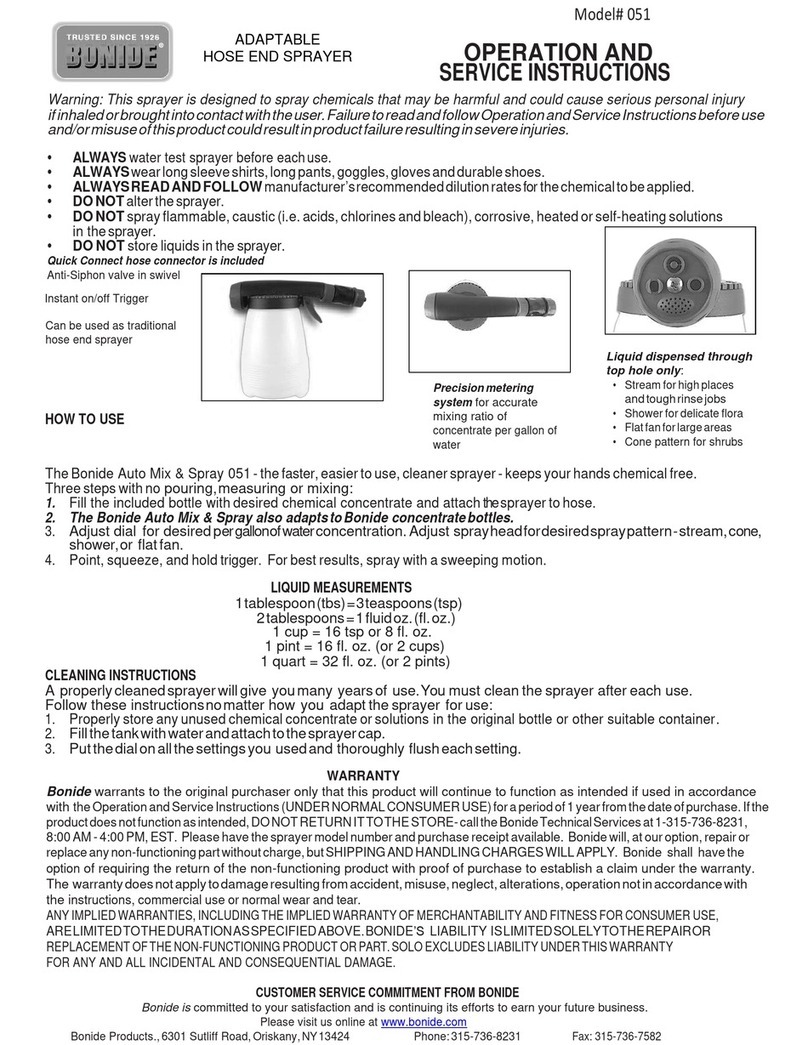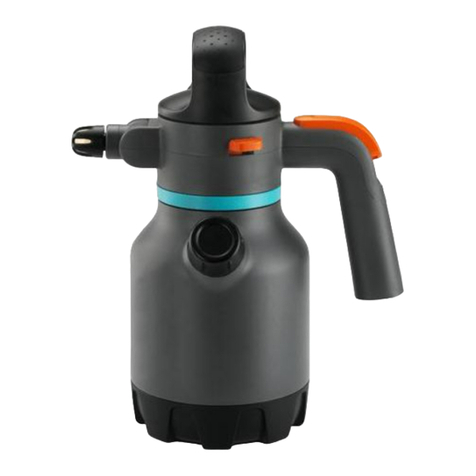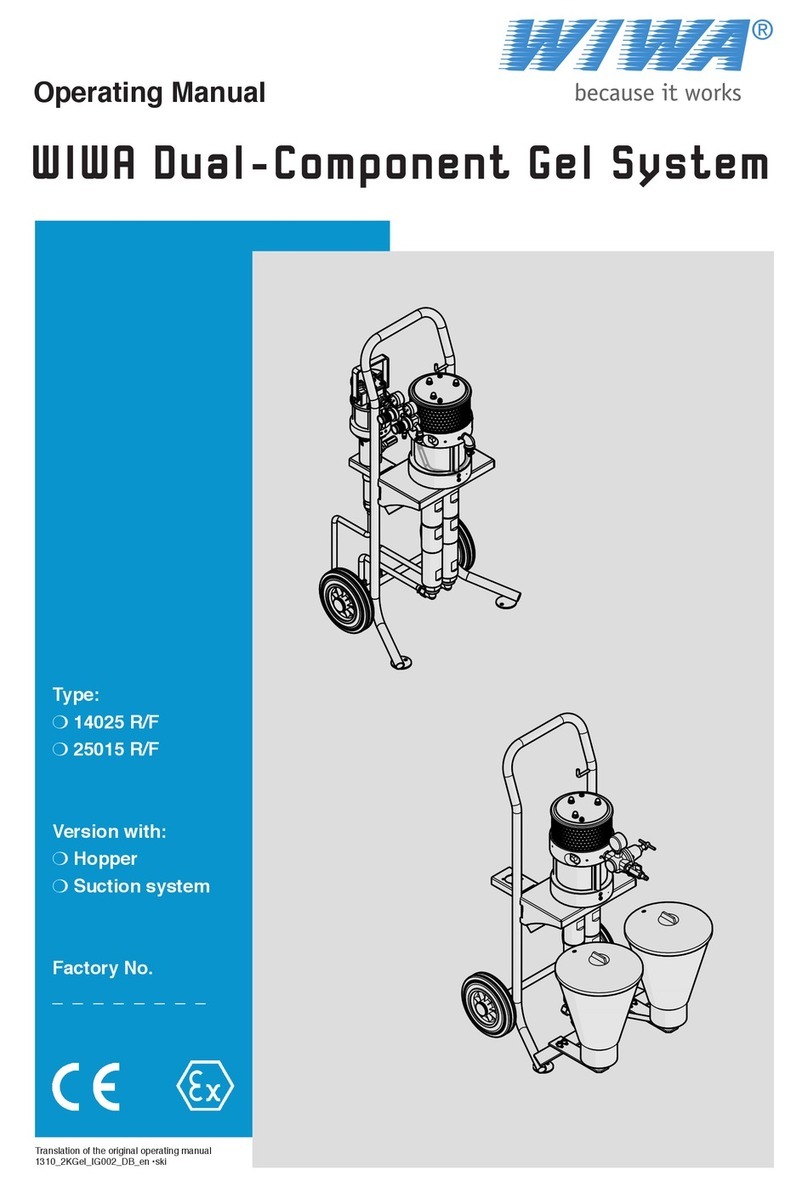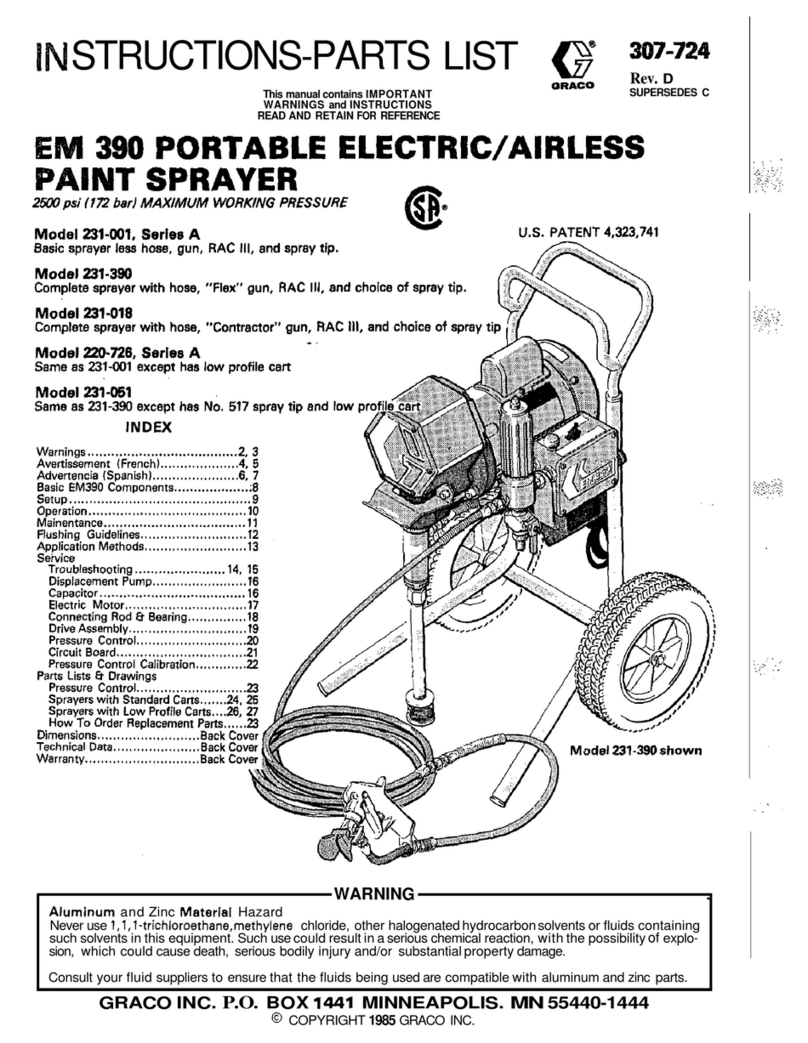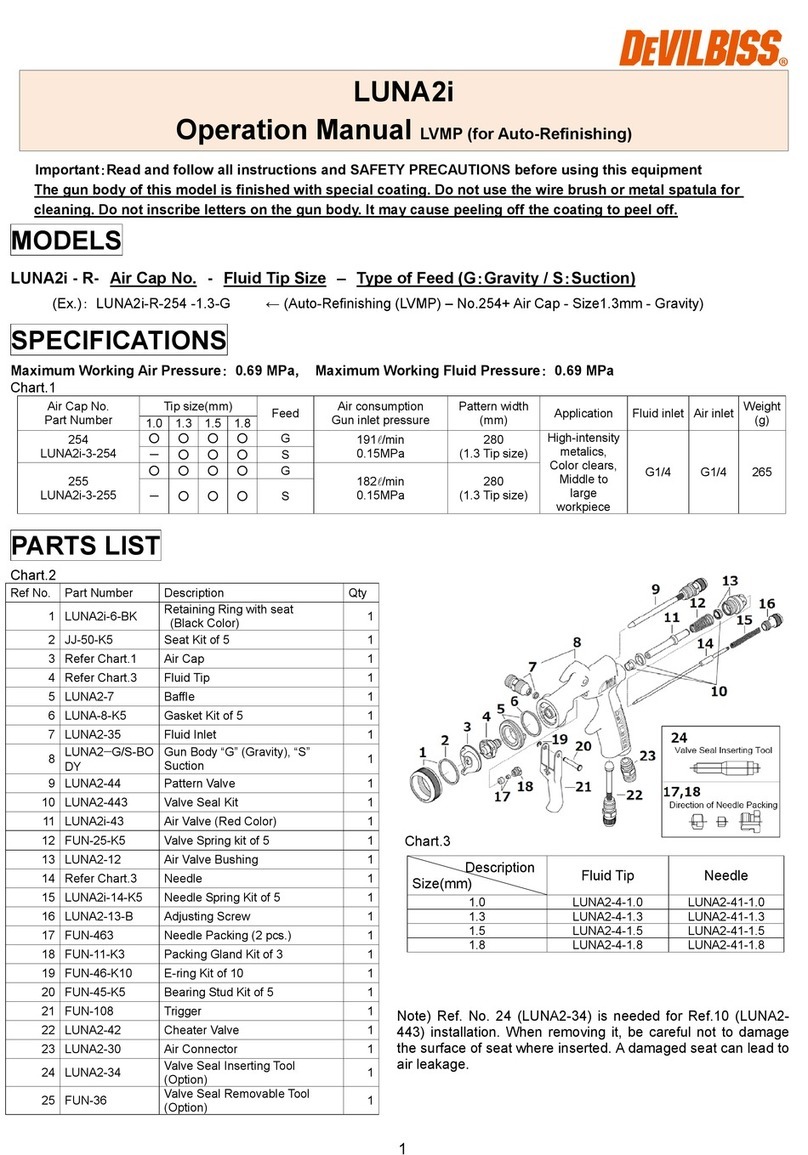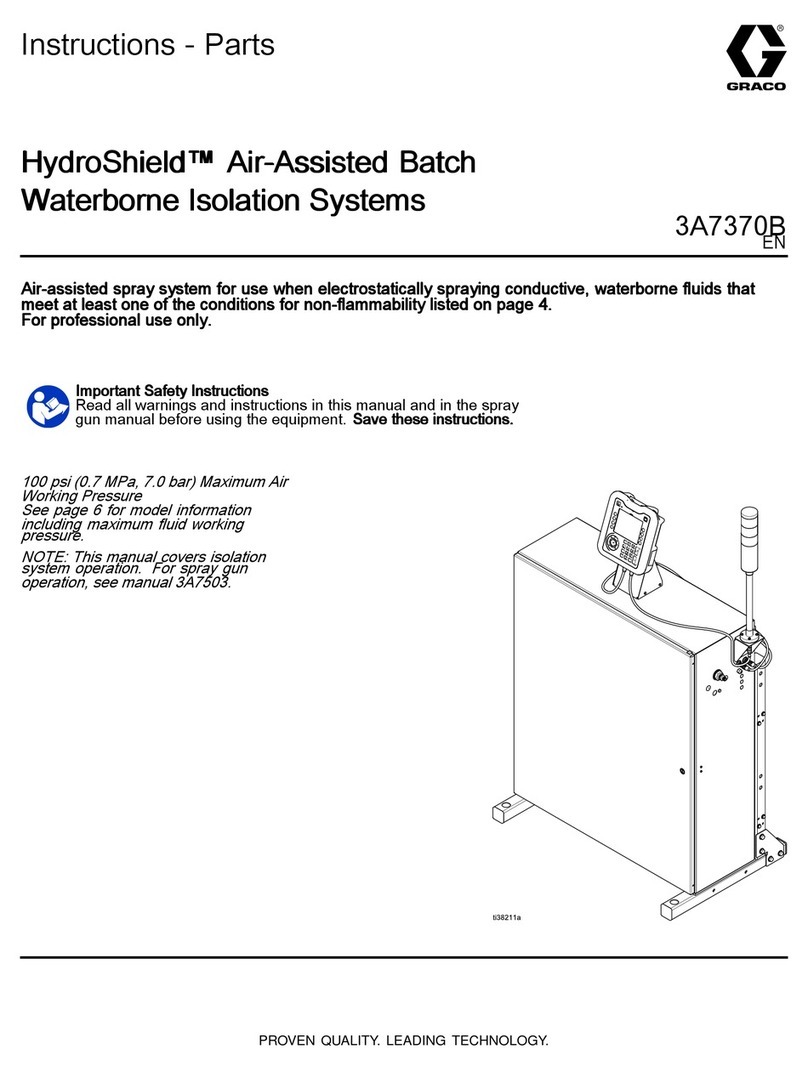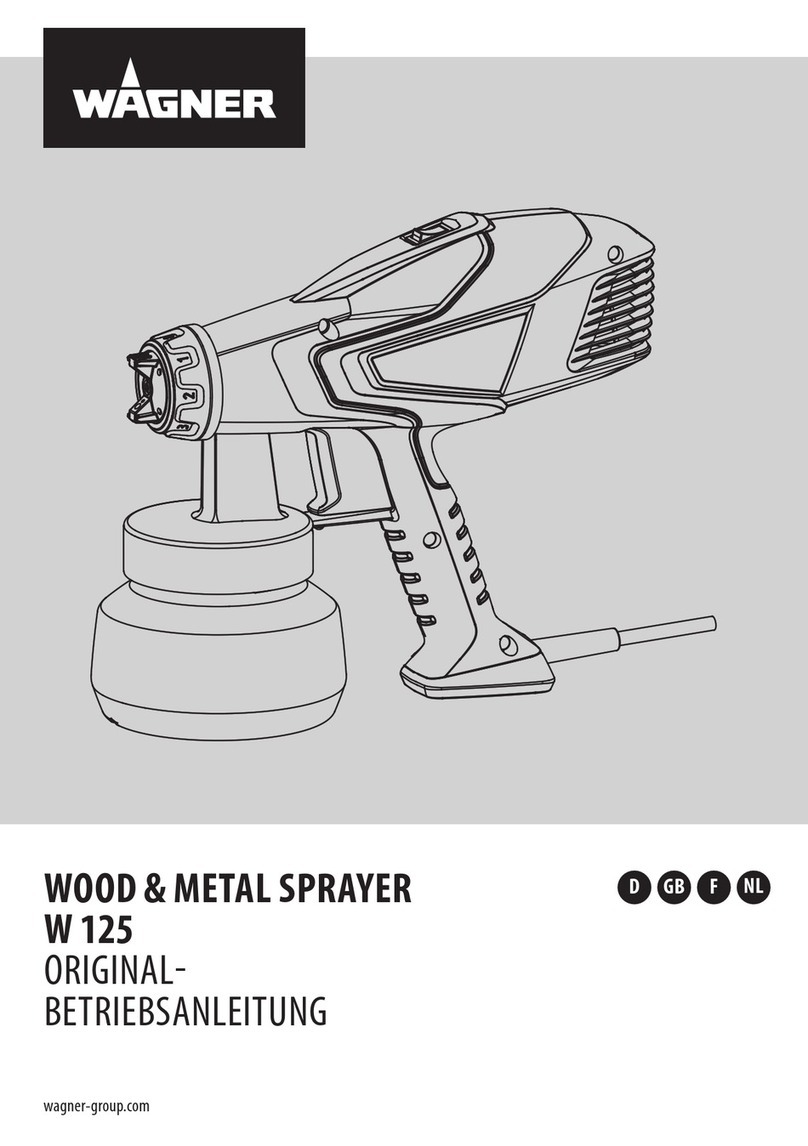20 Sp
Manual de Instrucciones y Lista de Piezas Pistola Pulverizadora HVLP Alimentada por Gravedad
Nunca exceda la presión de
trabajo de ninguna de las
partes (mangueras, co-
nexiones, etc.) del sistema para pintar.
Mantenga
las
mangueras alejadas de objetos aflilados.
Si éstas explotan le podrían ocasionar
lesiones. Revise las mangueras con regu-
laridad y reemplácelas si están dañadas.
7. Siempre use un regulador de pre-
sión en la fuente de suministro de
aire para la pistola pulverizadora.
Si no le
instala el
equipo adecuado para remover
agua/aceite podría ocasionarle daños al
equipo o la superficie que esté pintando.
Introducción
La pistola pulverizadora es una parte
esencial en la aplicación de pintura.
Además de operar la pistola pulver-
izadora adecuadamente, el usuario
debe familiarisarse con las técnicas de
preparación de la superficie y la pintu-
ra. Las siguientes instrucciones le expli-
carán las diferencias entre los difer-
entes métodos utilizados para rociar y
le servirán de guía para la operación
del equipo y los métodos para pintar
con pistolas pulverizadoras. Vea la
información especifica sobre cada
modelo en la lista de repuestos.
TERMINOLOGÍA DE LAS PISTOLAS
PULVERIZADORAS
Atomización - Es el proceso para conver-
tir líquidos en gotas minúsculas (rocío).
Con Purgador – En este método, el
aire circula continuamente a través de
la pistola aunque no esté rociando. Este
método generalmente se usa cuando el
aire lo suministra un compresor de aire
de uso continuo sin tanque.
Con Purgador/Sin Purgador – Le
indica si el flujo de aire a través de la
pistola es continuo o sólo cuando se
oprime el gatillo.
Mezcla – Es la mezcla de pintura y aire
para rociar.
Mezcla Externa – Es el proceso de
mezclar la pintura con aire fuera de la
boquilla de aire. Este método se debe
usar con pinturas que se secan rápida-
mente y cuando necesite un acabado
de buena calidad.
Mezcla Interna – Es el proceso de
mezclar la pintura con aire dentro de la
boquilla de aire, antes de rociarla. Este
método es mejor para pinturas espesas,
pinturas que tardan en secarse, y sólo se
puede usar con el sistema a presión.
Nunca use el método de mezcla interna
cuando vaya a rociar pinturas que se secan
rápidamente. De hacerlo, la pintura se
secará dentro de la boquilla y la atascará.
Perilla de Control de Fluído – Se usa
para controlar la cantidad de pintura
que se mezcla con aire.
Perilla de Control de Patrón – Se usa
para seleccionar el patrón adecuado
(tamaño y forma) de la pintura rociada
con la pistola cuando se quiere pintar
una superficie.
Sin Purgador – En este método, el aire cir-
cula sólo cuando se oprime el gatillo. Este
método de suministro se usa con compre-
sores de aire con tanque o con grandes sis-
temas de suministro de aire en una fábrica.
Sistema a Presión – Es un método por
el cual se le aplica presión al envase o
tanque de pintura para suministrarle
pintura a la pistola. Este método puede
utilizar boquillas de aire de mezcla inter-
na o externa. Este método generalmente
se usa para rociar pinturas espesas o para
pintar superficies grandes.
Sistema de Alimentación – Es el
método usado para suministrarle a la
pistola la pintura que se va a rociar.
Sistema de Gravedad – Este método
es similar al de sifón. Sin embargo, el
envase está invertido para crear una pre-
sión positiva del fluído en la boquilla.
Sistema de Sifón – En este método se
utiliza la presión atmosférica para crear
un vacío parcial para suministrarle la
pintura a la pistola. Con este método
sólo se pueden utilizar boquillas de aire
de mezcla externa. El sistema de sifón
se usa para rociar pinturas que no sean
muy espesas.
Tanque de Pintura – Un envase adi-
cional de pintura bajo presión que per-
mite el rocío continuo de grandes superfi-
cies sin necesidad de parar para volver a
llenar de pintura los envases. Éste tam-
bién le permite usar la pistola
pulverizadora en cualquier ángulo sin
que la pintura se derrame.
Viscosidad – Es la resistencia al flujo
de los líquidos.
TRADICIONAL VS. HVLP
Las pistolas pulverizadoras tradicionales
usan una presión mucho más alta en la
boquilla de aire para atomizar la pintu-
ra que las pistolas HVLP. Ésto ocasiona
mayor malgasto de pintura y menos
eficiencia.
Los métodos HVLP, electrostáticos y sin
aire son actualmente los únicos que le
garantizan un 65% de la eficiencia que
exigen ciertos departamentos de con-
trol de contaminación ambiental. Esta
mayor eficacia le permite un ahorro sig-
nificativo de material al compararlo con
los métodos tradicionales para rociar
pintura. Cerciórese de revisar las regula-
ciones vigentes locales, estatales y
nacionales antes de utilizar cualquier
tipo de pulverizadoras de pintura.
El método HVLP se ha convertido en el
más popular a nivel industrial debido al
bajo índice de contaminación ambiental
que produce. Según la definición, las
presiones del aire dinámico dentro de la
boquilla de aire deben ser 0,69 bar ó
menos para calificar como un sistema
HVLP. Aquí se produce un patrón de
baja velocidad el cual
aumenta el control y
reduce las corrientes
contrarias y el mal-
gasto de material
(Vea la Figura 1). Por
lo tanto, el método
HVLP es muy bueno
para pintar superfi-
cies con escondrijos.
Conexión de la
Pistola Pulverizadora
La presión de aire para atomizar se con-
trola en la fuente de suministro de aire.
La cantidad de fluído se ajusta con la
perilla para controlar el fluído, la viscosi-
dad de la pintura y la presión del aire. El
envase con sis-
tema de ali-
mentación de
gravedad se
atornilla a la
parte superior
del cuerpo de
la pistola y
crea una pre-
sión positiva
de flujo en la
boquilla (Vea
la Figura 2).
Figura 1
Tradicional
HVLP
Informaciones
Generales de
Seguridad (Continuación)
Figura 2 - Conexión del
sistema
de gravedad
Fuente de
suministro
de aire fil-
trado, reg-
ulado
MÉMENTO: Gardez votre preuve datée d'achat à fin de la garantie!
Joignez-la à ce manuel ou classez-la dans un dossier pour plus de sécurité.
S’il vous plaît lire et conserver ces instructions. Lire attentivement avant de monter, installer, utiliser ou de procéder à l’entretien du produit
décrit. Se protéger ainsi que les autres en observant touutes les instructions de sécurité, sinon, il y a risque de blessure etiou dégâts matériels!
Conserver ces instructions comme référence.
Description
Ce pistolet vaporisateur est conçu pour
vaporiser tout matériau de viscosité
légère à moyenne, comme l’émail, la
laque, le polyuréthane, la couche de
finition d’uréthane (y compris couche
de fondation/couche claire) et tous les
apprêts. Le pistolet pulvérisateur a des
contrôles de fluides et de modèles. Ce
pistolet est fourni avec un godet d’ali-
mentation par gravité de 600 ml.
Directives de Sécurité
Ce manuel contient de l’information très
importante qui est fournie pour la
SÉCURITÉ et pour ÉVITER LES PROBLÈMES
D’ÉQUIPEMENT. Rechercher les symboles
suivants pour cette information.
Danger
indique
une situation hasardeuse imminente
qui RÉSULTERA en perte de vie ou
blessures graves.
Avertis-
sement
indique une situation hasardeuse
potentielle qui PEUT résulter en perte
de vie ou blessures graves.
Attention
indique
une situation hasardeuse potentielle
qui PEUT résulter en blessures.
Avis
indique
l’information importante pour éviter le
dommage de l’équipement.
Déballage
Lors du déballage, l’examiner
soigneusement pour rechercher toute
trace de dommage susceptible de s’être
produit en cours de transport. Serrer
tous raccords, boulons, etc., avant d’u-
tiliser le modèle.
Ne pas
utiliser
un outil qui a été endommagé pendant
le transport, la manipulation ou l’utili-
sation. Le dommage peut résulter en
éclatement et peut causer des
blessures ou dégâts matériels.
Généralités sur la
Sécurité
PROPOSITION 65 DE CALIFORNIE
Vous pouvez créer de la pous-
sière en coupant, ponçant,
pulvérisez, perçant ou meu-
lant les matériaux tels que le bois, la
peinture, le métal, le béton, le ciment
ou autre maçonnerie. Cette poussière
contient souvent des produits chim-
iques reconnus pour causer le cancer,
les déformations congénitales ou
autres problèmes de la reproduction.
Porter de l’équipement de protection.
GÉNÉRALITÉS SUR LA SÉCURITÉ
1. Lire attentivement tous
manuels compris avec ce
produit. Se familiariser
avec ce produit, ses com-
mandes et son utilisation.
2. Suivre tous les codes de sécurité et
d’électricité locaux ainsi que les
codes des É.-U.; National Electrical
Codes (NEC) et Occupational Safety
and Health Act (OSHA).
Utiliser un masque/respira-
teur et des vêtements pro-
tecteurs pendant la pulvéri-
sation. Toujours pulvériser dans un
endroit bien ventilé afin d’éviter les
hasards de santé et de feu. Se référer
aux données de matériaux de pulvéri-
sation; Material Data Sheets (MSDS)
pour plus de renseignements.
Ne jamais pulvériser plus près
que 25 pieds du compresseur!
Si possible, placer le com-
presseur dans un endroit séparé. Ne
jamais pulvériser vers le compresseur, sur
les commandes ou son moteur.
3. Ne pas fumer ni manger pendant la
pulvérisation de peinture, d’insecti-
cides, ou autres matières inflammables.
Ne pas pulvériser des matéri-
aux inflammables près d’une
flamme ou autres sources d’ig-
nition. Les moteurs, l’équipement élec-
trique et commandes peuvent causer des
arcs électriques qui peuvent allumer un
gaz ou une vapeur inflammable. Ne pas
entreposer des liquides ou des gaz
inflammables près du compresseur.
Ne pas
abuser ce
produit. L’exposition excessif à la
vibration, au travail dans les positions
d’accès difficile et le mouvement
répététif peuvent causer des blessures
aux mains et aux bras. Arrêter d’utiliser
un outil et consulter un médecin si vous
avez le malaise, l’engourdissement, le
picotement, ou la douleur.
4. Pendant la pulvérisation et le net-
toyage, suivre les instructions et les
précautions de sécurité fournies par
le fabricant des matériaux (Se
Référer au MSDS).
Ne pas
pulvériser
des acides, matériaux corrosifs, pro-
duits chimiques toxiques, les engrais
ou pesticides. Ceci peut résulter en
mortalité ou en blessure grave.
5. Garder les visiteurs à l’écart et NE
JAMAIS permettre les enfants ni les ani-
maux familiers dans l’endroit de travail.
Ne
jamais
diriger la pulvérisation vers soi-même
ni vers une autre personne. Ceci peut
causer des blessures graves.
6. Toujours travailler dans un environ-
nement propre. Ne pas diriger le
pistolet vers la poussière ou le
débris afin d’éviter des blessures
personnelles, ainsi que le dommage
à l’objet de travail.
Pistolet Vaporisateur à
Alimentation par Gravité HVLP
Instructions d’Utilisation et Manual de Pièces HDS790
